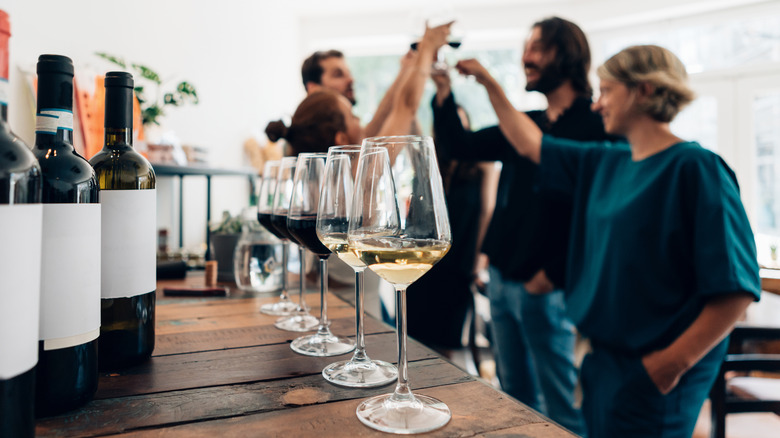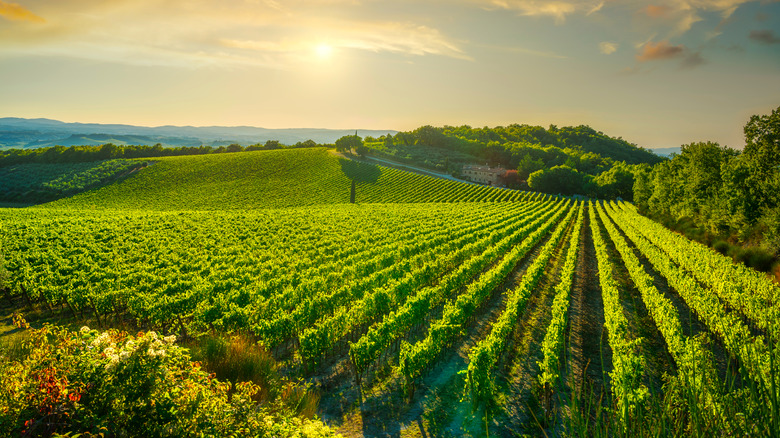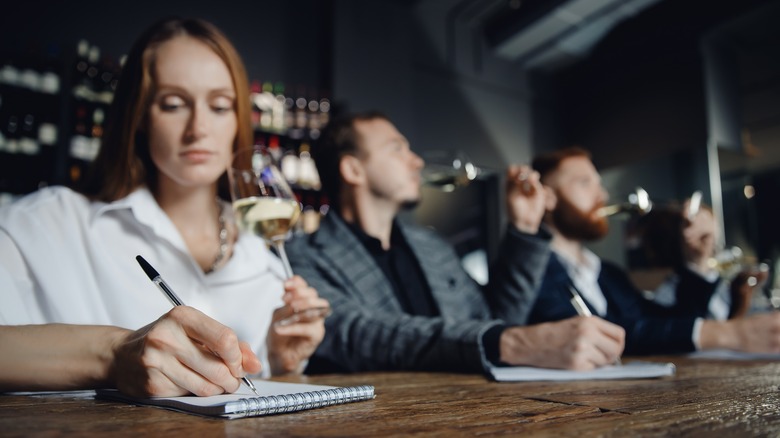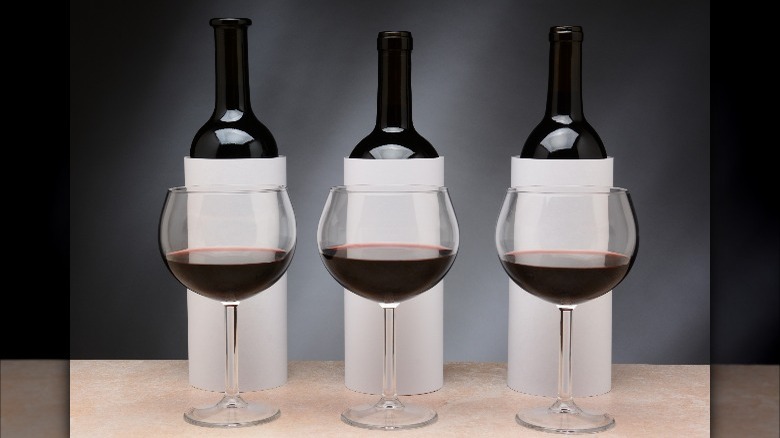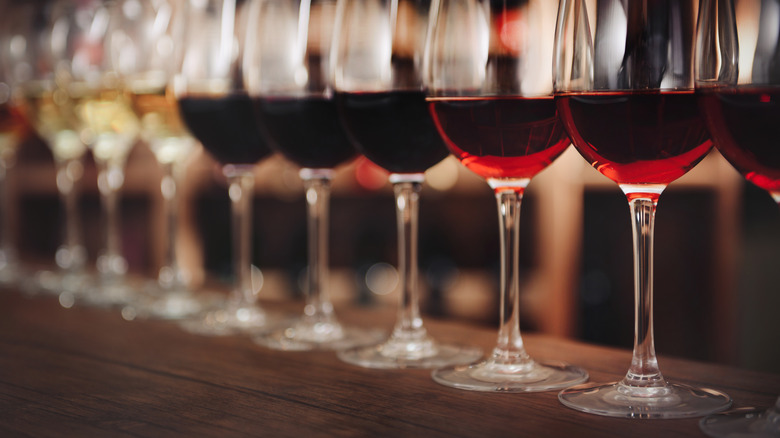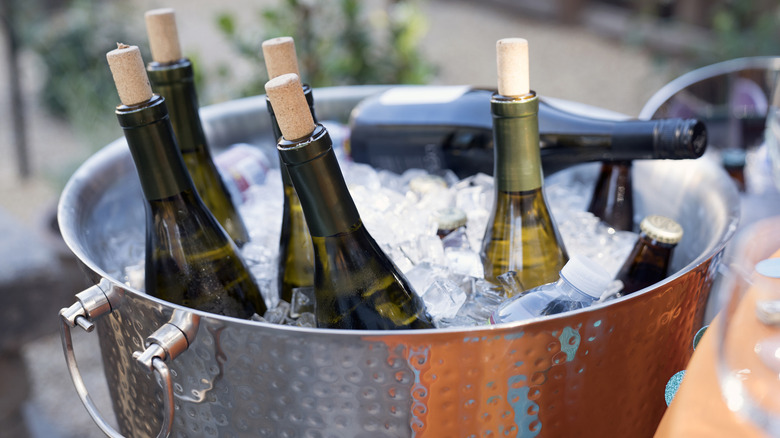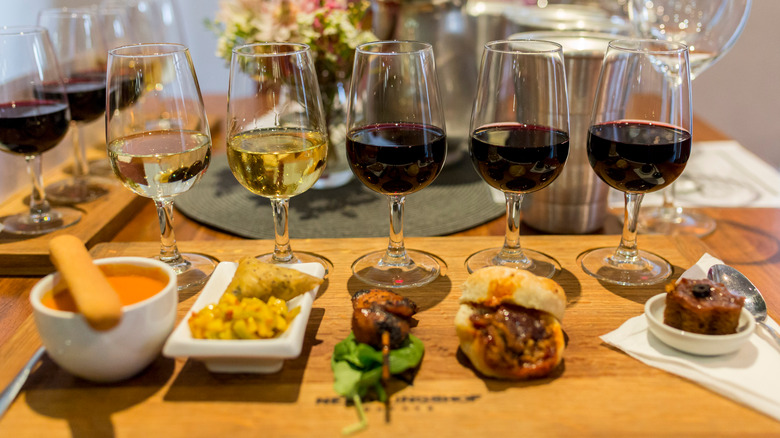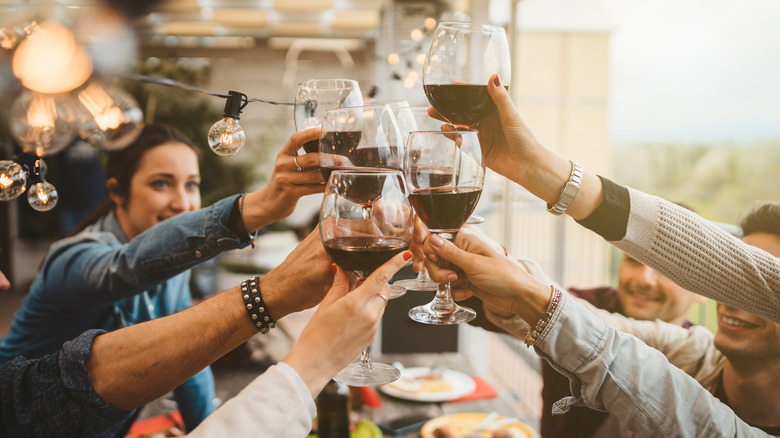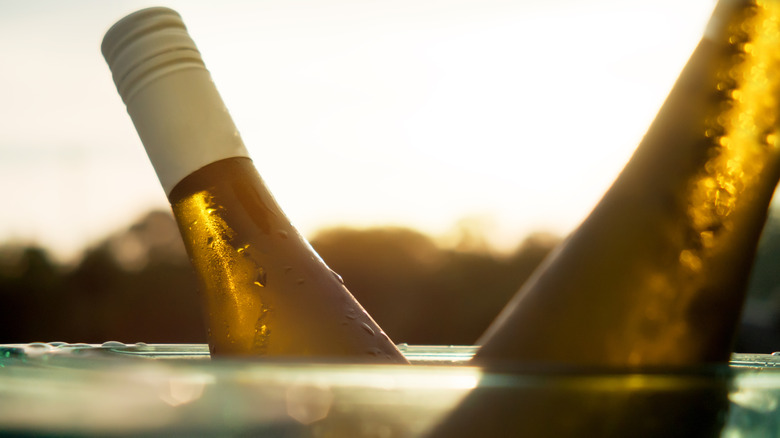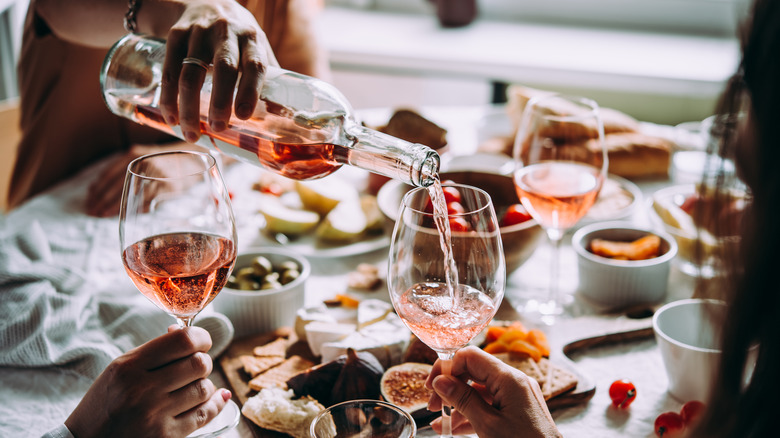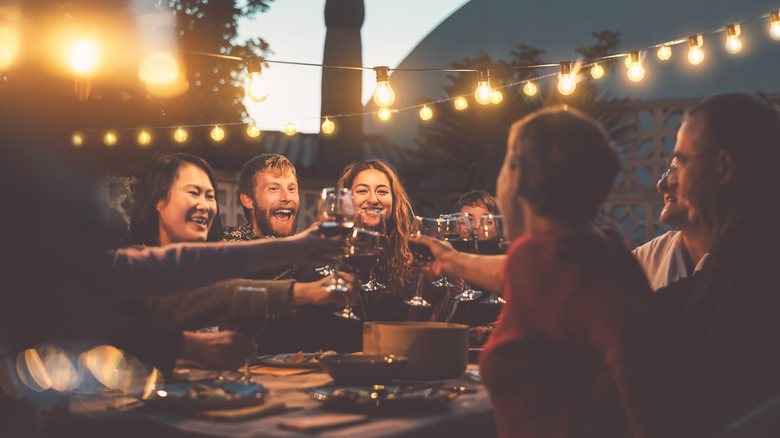Everything You Need To Know When Having A Wine Tasting Party
If your experience drinking wine is limited to imbibing, then you are missing out on fun — not to mention the beverage's vast potential. While tasting the stuff is always enjoyable (especially with a good food pairing), it's well worth adding a few elements to the mix. Next time you're looking for ideas for a gathering, how about hosting a wine tasting party?
The central focus will undoubtedly be the wine, but there are countless ways you can take this idea and run with it. From choosing various themes like regions, styles, and grapes to blind tasting (with or without a blindfold) or serving up your favorite wine and food pairings, there's plenty of room to learn and have fun.
Nonetheless, to limit any stress (it is a party, after all), it helps to have a game plan, so you aren't frantically washing glasses before the next pour. Read on for our collection of top tips for planning a wine tasting event, so you can be free to enjoy the party.
Pick a theme to streamline the experience
You don't have to walk around with a clipboard and instruct your guests on their every move, but some structure will prevent the event from lacking direction. Having parameters of comparison or an overarching theme tying everything together can make the occasion a fun learning experience. In addition, wine availability will be a guiding factor since there's no use focusing on an obscure grape or region if you can't find any examples at your local wine shop.
For example, picking a handful of international wines made with Chardonnay is an excellent way to dive into the grape's nuances. You might even highlight climate influence by choosing a varietal from a cool vs. warm climate. For example, we guarantee that Chardonnay from California has different elements compared with one from Chablis in northern France.
Similarly, selecting wines from a single country can give you a closer look at the characteristics of a region. If you're ready to take it further, choose wines from a producer over a few years, aka a vertical tasting. This will give you some insight into the yearly weather conditions and how they affect the resulting wine. If you're not ready to go the whole educational route, a fun option is to pick wines in a range of price points and determine whether you can taste the difference. Finally, for people with an aesthetic eye, ask each of your guests to bring a bottle with a label they love.
Focus on specific details in your tasting
You could just sip your wine and make the right sounds to show appreciation, but having a guideline is helpful. A swirl here, a sniff there, a delicate sip — taking a moment to be deliberate will evoke a more profound sensory experience. Start by taking a look at your wine. Red wine has a spectrum of hues like ruby, garnet, plum, and inky purple. Meanwhile, white wine is rarely transparent, with golden or greenish highlights. For the best assessment, use a white background to contrast. Wine legs (not the dancing kind) provide information on sugar and alcohol content, and more viscous liquids typically contain more of both (via Wine Folly).
Next, smell the wine in your glass and list the various aromas you notice. A tasting chart is a great way to access an endless selection of scents. To get the most out of each sniff, be sure to leave enough space in the glass to swirl easily. In an interview with Tasting Table, Jason Santos, sommelier and training manager at Justin winery, explains that the action "volatizes the molecules and you'll actually get a more intense aroma, but different aromas as well."
Finally, savor the first sip by keeping the wine in your mouth and noticing additional flavors. You can even start the evening by making guests taste sweet, salty, sour, and bitter foods to identify these features in your wine.
Decide whether you will blind taste
Blind tasting is often perceived as a magical feat, but the truth is that it can be learned with sufficient practice. Typically, blind tasting doesn't involve an actual blindfold, but you could, of course, use one for theatrical effect. A more practical option, however, is to wrap the wine bottles to conceal their identity. To avoid confusion, designate each bottle with a number so that you can refer to them in your tasting notes.
You could ask everyone to bring a bottle of mystery wine and compare two with regard to various factors to see if anyone can discover what's what. But, of course, if you leave the selection random, the chances of anyone guessing what's in their glass quickly drop. A better option to potentially have some successful guesses is to stick with a theme such as Pinot Noirs from around the world. To facilitate the blind tasting aspect, the regions can be listed, and tasters must match them to each bottle.
Another idea is to compare incognito wines at high and low price points and see if anyone gets them right. According to the results of a 2018 study published in the Journal of Wine Economics, participants didn't report significantly greater interest in pricier wines. Whether this holds true or not with your guests, it's sure to spark a debate about the value, taste, and overall sensory pleasure.
Games enhance the learning experience
If you're hosting a wine tasting party and want to distinguish it from a full-blown educational class, be sure to plan for games. The simplest option is to purchase an actual wine tasting game, such as Blinders by SOMM. The assorted cards consider various factors such as acidity, tannins, the use of oak, regions, and grape varieties to guess which of the listed wines you are tasting. Marketed for beginners and advanced tasters, this compact game is sure to be a winner. Sommify is a board game with a similar premise, so there's no shortage of options for a fun night.
Wine trivia is always a great idea, and you can intersperse tasting moments based on the various questions that come up. Play your own version of "The Price is Right" by having guests bring bottles and asking everyone to guess the price following a sip. Variations on Bingo and 21 Questions are just a few other ideas to liven up the night. While many games can incorporate the actual tasting aspect, playing wine-themed games independent of the wines you are trying is also sure to animate your guests.
Plan for plenty of clean glasses
Nothing ruins the fun of a party like finding yourself scrambling to wash extra wine glasses because you've run out. Realistically, depending on the size of your gathering, you may not have extra reserves of glassware at home. You could opt to purchase a box of affordable glasses, though keep in mind that they may not have the desirable features of more expensive ones, such as being lightweight, made of thin glass or crystal, and having a favorable shape (via Epicurious). Alternatively, ask everyone to bring their own glasses — as a bonus, you might not even have to wash them! For a professional setup, renting out glassware is generally feasible. Seek out party supply rental companies or caterers for an easy solution.
If your tasting is all about the precision of aromas and flavors and you plan to compare various wines with one another, then having a glass for each pour is necessary. Similarly, for an optimal experience, using slightly narrower tasting glasses allows the aromas to be directed more easily toward your nose. However, if the tasting will progress with a bottle or two open at a time, you can get away with two glasses per guest — one for white and one for red. A quick rinse with water between wines will keep your guests hydrated and their glasses clean.
Remember to have necessary supplies on hand
You've picked your wines and arranged glassware, so the basics are covered. However, to elevate your wine tasting party, it's worth seeking out a few additional items. For example, if you are moving around, charms or a special marker to identify glasses will avoid a game of "Whose glass is this?" Also, a cooling method to keep your bottles at a suitable temperature is ideal. It's not only crucial for white wine — consider the ambient temperature and decide whether you want your glass of red to get that hot.
Next, white background for the glasses and tasting grids can take the experience from amateur to professional in a second. On the same note, you can purchase a wine tasting kit with dozens of aromas to sniff to help identify what's in your glass. And if you're looking for the most educational experience, have paper and pens handy for taking notes.
A decanter is a convenient way to conceal wines, not to mention that young, tannic wines benefit from aeration, whereas old reds can be separated from sediment (via Fine Dining Lovers). Depending on the party vibe and how many bottles you are serving, a spittoon will keep you sharp as the night progresses. On the same note, water and bread will help prevent palate fatigue while keeping you hydrated and on the ball for each pour. Finally, eliminate the stress of spills with a wine stain remover.
Choose your food pairings wisely
We've mentioned the importance of some starchy snacks to keep your palate awake between pours, but you might want to take it a step further. For a genuinely elaborate event, a full dinner with wine pairings is sure to be a memorable affair. However, you don't have to take your hosting skills to that level to highlight some tasty matches between food and wine. Simple appetizers, canapes, and snacks are an easy way to enjoy complementary and contrasting flavors without spending all day in the kitchen.
If you want the various bottles to stand out, you're best off sticking to milder foods that won't overwhelm the wines. Cheese boards, charcuterie platters, and crispy, savory pastry bites are some reliable options. Be sure to load up on assorted crackers and bread, and add some nuts, dried fruits, and olives for a sophisticated touch.
Alternatively, you can hone in on a theme by pairing Italian wines with appetizers like cantaloupe and prosciutto, bruschetta, and bite-sized pizza. The same goes for any wine origin and its regional delicacies. Finally, if you want to get your guests involved, consider this the ultimate potluck: Ask everyone to bring their favorite wine and light food pairing. You're sure to end up with an eclectic mix of flavors.
Avoid hosting a large crowd
It's easy to get carried away and invite all of your closest friends and their friends too, but unless you want your wine tasting to turn into just any old party, it's worth keeping the numbers low. The actual physical space and structure you plan to follow will make a difference in who you decide to invite. If you're planning to do a step-by-step sensory analysis of each wine, then you'll want to be able to seat your guests comfortably at a table.
On the other hand, if the idea is to have fun guessing wine prices, choosing the best food and wine pairing, or playing games, you can stand to invite a few more people. We would probably recommend capping it at around 10 to 12 guests to avoid too much chaos. If you're accustomed to hosting events and feel ready to take on more people, then, by all means, go ahead. Just remember to think about the number of bottles, glasses, and assorted supplies you'll need to satisfy the troops. And for the best aromatic experience, Jason Santos warns that perfume can really get in the way; it might be worth mentioning to your guests in the invite if you're aiming for a serious tasting.
Pay attention to wine serving temperature
A wine's aromas and flavors evolve as the liquid changes temperatures. Sommelier Chevonne Ball reports that serving your wine overly chilled subdues flavors, acidity, and fruitiness, whereas wine that's too hot is bitter with alcohol-heavy flavors (via Martha Stewart). There's a reason you shouldn't be serving your red wine at room temperature in the dead of summer. If you're serious about it, use a thermometer; however, a few simple guidelines can lead you in the right direction.
Wine Enthusiast recommends drinking most sparkling wines between 41 and 45 degrees and vintage Champagne up to 50 degrees which can be achieved by chilling the bottle for two hours in the fridge. Lighter whites can be served between 45 and 49 degrees, and rosés can go up to 53 degrees; so cool the bottles for an hour and a half. Meanwhile, weightier white wines have a greater depth and complexity and can stand to be served slightly warmer between 50 and 55 degrees, or chilled for one hour in the fridge. Finally, light reds taste great between 54 and 60 degrees (45 minutes to an hour in the refrigerator), while full-bodied ones can go up to 65 degrees (25 minutes).
Have an ice bucket on hand if you're planning to have a few bottles open at a time. And make a point to taste the wines chilled and as they warm up to notice the nuances of flavor for yourself.
Be careful not to overdo it with portions
There's no bigger disappointment than realizing the party is only getting started, and you've run out of wine. Conversely, an event can quickly turn sour if the booze flows too freely. That being said, it's easy to attain a balance by considering a few elements and making some simple calculations.
According to the National Institute of Alcohol Abuse and Alcoholism, one standard serving of wine is 5 ounces. However, considering that the idea is to taste various bottles, your pours should be about half that amount. Given that a regular 750-ml bottle of wine contains 25.3 ounces, each bottle will count between eight and 12 tastings. Etiquette Scholar recommends calculating one bottle of wine per person to be certain, but these figures may change based on factors such as whether or not your guests are driving or using spittoons. Also, if you are hosting a short cocktail hour event, you probably won't get through that much. Regardless of the exact figures, be sure to have a sufficient quantity and variety for your tasting so that all of your guests can taste the selection — if that's the structure you're aiming for.
Remember that it's a party
Amidst all our tips and advice, the most essential one is to keep in mind that you are hosting a party. Unless your wine tasting is meant as a training session for a certification exam, the ultimate goal is to have fun while sprinkling in some education. If the structure, setup, or schedule begins to feel too rigid, you might want to take a step back and lighten up. There's no use planning a party if you'll be stressed out the whole time.
Similarly, if you intend to have a guided wine tasting session with a grid and aroma kit, then be sure to give your guests a warning so they know what to expect. If it starts to feel like you're trying to herd a flock of sheep somewhere it doesn't want to go, it might be the case to let go of some of your expectations for the event and relax. As Jason Santos notes in an interview with Tasting Table, "It's probably going to be fun for the first 30 minutes, maybe an hour if you have some enthused friends. But, after that, you're going to be talking to yourself."
Ultimately, as long as you crack open a few bottles and your guests leave with a renewed appreciation for wine, the evening was a success.
